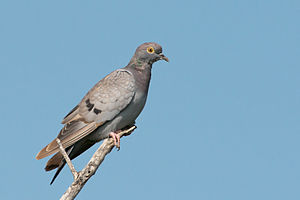Bank pigeon
| Bank pigeon | ||||||||||
|---|---|---|---|---|---|---|---|---|---|---|

Bank pigeon ( Columba eversmanni ) |
||||||||||
| Systematics | ||||||||||
|
||||||||||
| Scientific name | ||||||||||
| Columba eversmanni | ||||||||||
| Bonaparte , 1856 |
The bank pigeon ( Columba eversmanni ), also called yellow-eyed pigeon or eastern stock dove , is a type of field pigeon . It occurs in Asia.
Appearance
The bank pigeon reaches a body length of 26.5 centimeters. It is very similar in appearance and behavior to the stock dove . However, her physique is more petite and she is slightly smaller than this species.
Unlike the stock pigeon, the front neck and chest are also mauve. The rear back and the upper half of the rump are light gray. The lower rump and the upper tail-coverts are dark gray. The beak is dark gray to brownish at the base and brightens to a yellow-green towards the tip. The iris is yellow. The outer skin of the eye is also cream-colored to pale yellow.
distribution and habitat
The bank pigeon occurs in Turkestan from the Aral Sea to the north of Afghanistan. In an easterly direction their distribution area extends to the Saissansee . As a winter guest, it also occurs in northern India and Pakistan. A small part of the population winters in Turkmenistan .
The bank pigeon lives in coniferous, deciduous and mixed forests at different altitudes.
behavior
The bank pigeon finds its food mainly on the ground. She also looks for agricultural land to forage. It mainly eats seeds and grains. Fruits also play a role. She especially likes to eat ripening mulberries .
The bank pigeon is one of the few pigeon species that are cave breeders. It breeds in tree hollows, but also in burrows, in steep slopes and erosion channels. After individual observations she also uses the burrows of the European roller . In northern Afghanistan, they reproduce between June and August. There is currently insufficient information about the breeding period and the duration of the nestling period.
supporting documents
Individual evidence
literature
- Gerhard Rösler: The wild pigeons of the earth - free life, keeping and breeding , Verlag M. & H. Schaper, Alfeld-Hannover 1996, ISBN 3-7944-0184-0
Web links
- Columba eversmanni inthe IUCN Red List of Threatened Species 2013.1. Listed by: BirdLife International, 2012. Retrieved October 30, 2013.